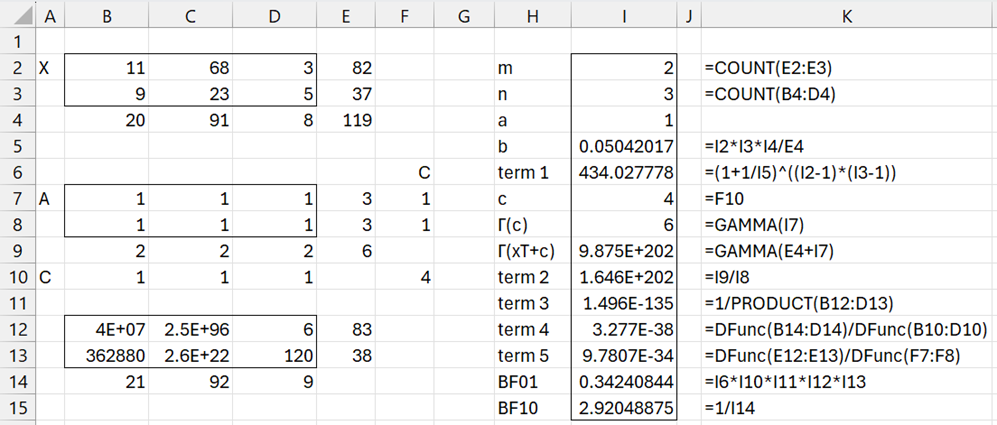Objective
We describe the Bayesian approach to determining whether the two variables defined by a contingency table are independent. This is the Bayesian equivalence to the chi-square test of independence or Fisher’s exact test. See also Bayesian Hypothesis Testing.
Terminology
We assume that we have an m × n contingency table X = [xij] and want to test the following hypotheses:
H0: Row/column independence
H1: Row/column dependence
We now define
We also assume priors A = [aij], and define similar quantities for the A matrix to those described above for the X matrix. In addition, we define the following:
Finally, for any m × n matrix Y = [yij], we define
and for any vector Y = [yi], we define
Example
We explain this terminology further using the contingency table in Figure 1.
Figure 1 – Contingency Table
Based on the above terminology, we see that
x21 = 2, x.1 = 11, xT = 34, Xcol = (11, 23), m = n = 2
If aij = 1 for all i,j, then aT = 4, Arow = Acol = (2,2)
Crow = (2-1, 2-1) = (1, 1), c = 4-1 = 3
D(Xrow) = Γ(18) ⋅ Γ(16) / Γ(34) = 17!15!/33! = 5.34652E-11
We now show how to test the independence hypotheses described above using several different approaches.
Poisson sampling
In this sampling approach, we assume that none of the cell counts are fixed. We assume that the cell counts follow a Poisson distribution where the mean/rate parameters λij have a gamma distribution with shape parameters aij and scale parameter b.
xij ∼ Poisson(λij)
λij ∼ Gamma (aij, b)
We assume that all the aij are the same with value a (default 1), and that the default for b is
b = mna/xT
The Bayes Factor for this sampling approach is
For a 2 × 2 contingency table with a = 1, it follows that
Example
Example 1: Calculate BF01 for the contingency table in range B2:D3 of Figure 2 based on the prior parameter a = 1.
We show the table of priors including totals in range B7:E9. Range F7:F8 contains Crow, B10:D10 contains Ccol, and cell F10 contains c. The right side of the figure calculates BF01 as a product of the 5 terms in the above formula. To simplify the calculations we use the DFunc worksheet function defined in Bayesian Independence Testing Support.
 Figure 2 – Poisson sampling example
Figure 2 – Poisson sampling example
Joint multinomial sampling
In the joint multinomial sampling approach we assume that only the grand total xT is fixed and
(x11, …, xmn) ∼ Multinomial(xT, π)
where π takes a Dirichlet distribution:
π ∼ Dirichlet(a11, …, amn)
In this case
For a 2 × 2 contingency table with a = 1, it follows that
Independent multinomial sampling
This time, we assume that either the row or column totals are known. If the row totals are known then
If the column totals are known then
For a 2 × 2 table with a = 1
Hypergeometric sampling
This time we assume that all marginal totals are fixed.
For a 2 × 2 table with a = 1
where we have chosen x1. to be the smallest of the marginal totals.
Worksheet Functions
Click here for a description of worksheet functions and data analysis tools that can be used to perform Bayesian independence testing in Excel.
Examples Workbook
Click here to download the Excel workbook with the examples described on this webpage.
References
Jamil, T., Ly, A., Morey, R. D., Love, J., Marsman, M., Wagenmakers, E-J. (2016) Default “Gunel and Dickey” Bayes factors for contingency tables
https://www.alexander-ly.com/wp-content/uploads/2014/09/JamilEtAlGunelDickeyinpress.pdf
Albert, J. (2009) Bayesian computation with R, 2nd ed. Springer

